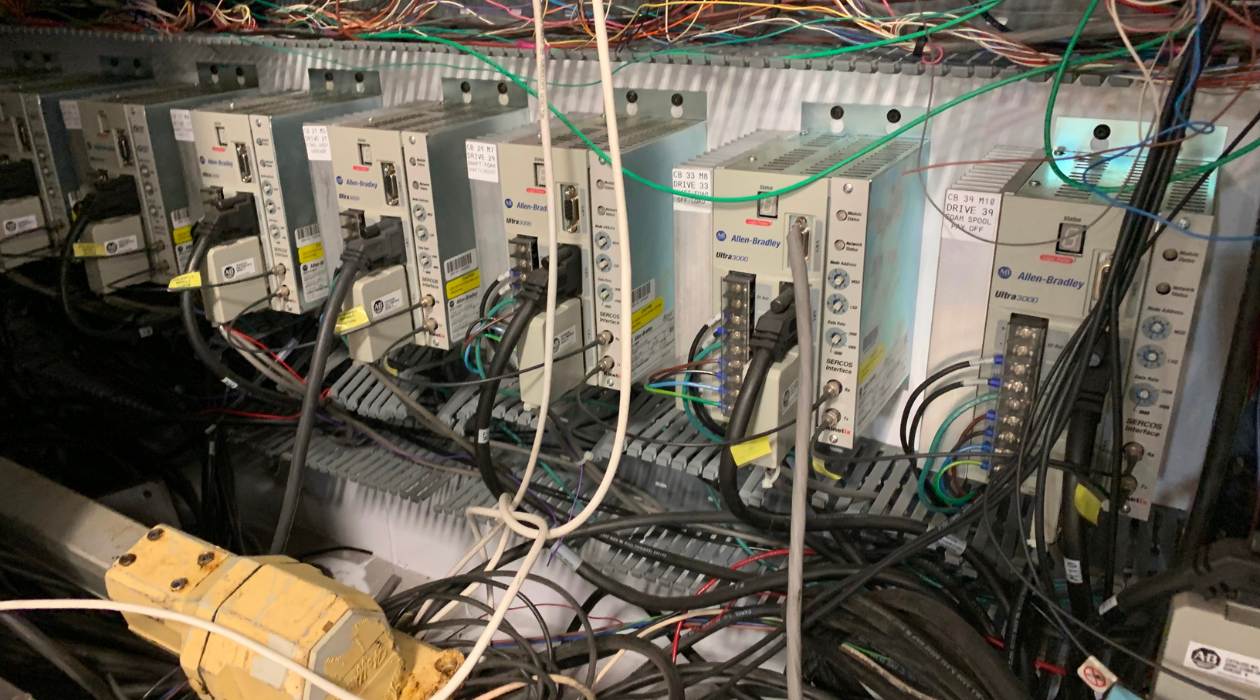Home>Articles>What Is The Difference Between Relay Controls And Communicating Controls HVAC


Articles
What Is The Difference Between Relay Controls And Communicating Controls HVAC
Modified: October 19, 2024
Learn about the key distinctions between relay controls and communicating controls in HVAC systems. Read more in our informative articles.
(Many of the links in this article redirect to a specific reviewed product. Your purchase of these products through affiliate links helps to generate commission for Storables.com, at no extra cost. Learn more)
Introduction
Welcome to the world of HVAC controls, where precision and efficiency are key. In HVAC systems, controls play a crucial role in regulating temperature, humidity, and ventilation. They ensure optimal comfort and energy management in residential, commercial, and industrial settings. Two popular types of controls in the HVAC industry are relay controls and communicating controls.
Relay controls have been used in HVAC systems for many years and have proven to be reliable and effective. On the other hand, communicating controls, also known as advanced or smart controls, are a more recent innovation. These controls have revolutionized the way we interact with HVAC systems, providing enhanced functionality and connectivity.
In this article, we will explore the key differences between relay controls and communicating controls HVAC, as well as their respective benefits, drawbacks, and applications. We will also discuss the cost and installation considerations and take a look at future trends and developments in the field. So, let’s dive in and discover the fascinating world of HVAC controls!
Key Takeaways:
- Relay controls offer cost-effective, reliable control for basic HVAC systems, making them suitable for residential, commercial, and industrial applications. Their simple design and compatibility with existing systems make them a trusted solution.
- Communicating controls HVAC provide advanced functionality, energy management capabilities, and integration features, allowing for optimized comfort and energy efficiency. Despite a higher initial cost, their long-term benefits and enhanced control make them an appealing choice for complex environments.
Read more: What Is The Difference Between Ac And HVAC
Definition of Relay Controls
Relay controls, also known as electromechanical controls, are the traditional method of controlling HVAC systems. They are based on the principle of using electromagnetically operated switches, called relays, to control various components and functions of the system. Relay controls are simple and straightforward, consisting of a series of switches that open and close to turn on and off different parts of the HVAC system.
Relay controls work by receiving signals from the thermostat or other control devices and activating the appropriate relays to control the HVAC equipment. These relays can control functions such as turning on and off the compressor, activating the blower motor, or opening and closing damper doors to regulate airflow.
Relay controls are typically hardwired and require separate wiring for each HVAC component. This means that each device or component, such as the thermostat, outdoor unit, and indoor unit, needs individual wiring connections. The simplicity of relay controls makes them reliable and easy to troubleshoot, as technicians can visually inspect the switches and wires to identify any issues.
However, relay controls have some limitations. Since they rely on physical switches and wires, they lack the advanced features and capabilities offered by modern communicating controls. Additionally, the separate wiring required for each component can be complex and time-consuming, especially in larger systems. Despite these limitations, relay controls have been widely used and continue to be a cost-effective solution for many HVAC applications.
Definition of Communicating Controls HVAC
Communicating controls HVAC, also known as advanced or smart controls, are a more advanced and integrated approach to controlling HVAC systems. Unlike relay controls, which rely on individual wires for each component, communicating controls use a single communication network to connect and control various devices and components.
Communicating controls utilize digital communication protocols, such as BACnet or LonWorks, to establish a seamless connection between different parts of the HVAC system. This allows for real-time data exchange and enables intelligent control and coordination of system operation. With communicating controls, the thermostat, indoor unit, outdoor unit, and other devices can “communicate” with each other, sharing information and making real-time adjustments to optimize performance.
One of the key advantages of communicating controls HVAC is the ability to gather and analyze data from different sensors and devices throughout the system. This data includes information about temperature, humidity, air quality, and energy consumption. With this wealth of data, HVAC systems can adapt and respond dynamically to changing conditions, improving comfort and efficiency.
In addition to data exchange, communicating controls offer advanced features such as zoning and scheduling. Zoning allows different areas or zones of a building to have independent temperature control, optimizing comfort and energy usage. Scheduling allows users to program the system to automatically adjust settings based on time and occupancy, further enhancing energy efficiency.
Communicating controls are typically easier to install and commission compared to relay controls. Since they use a single communication network, there is no need for extensive wiring. Instead, devices are connected using low-voltage wiring or wireless communication. This simplifies the installation process and reduces labor costs.
Overall, communicating controls HVAC provide enhanced functionality, connectivity, and energy management capabilities. They offer greater control, automation, and optimization of HVAC systems, improving comfort, energy efficiency, and overall system performance.
Key Differences between Relay Controls and Communicating Controls HVAC
Relay controls and communicating controls HVAC may both serve the same purpose of controlling HVAC systems, but they differ in several significant ways. Let’s examine the key differences between these two types of controls:
- Wiring and Connectivity: Relay controls require separate wiring for each component of the HVAC system, whereas communicating controls use a single communication network for connectivity. This makes communicating controls easier to install and eliminates the need for extensive wiring.
- Data Exchange and Integration: While relay controls primarily operate using switches and relays, communicating controls HVAC enable real-time data exchange and integration between different devices and components. This allows for advanced functions such as zoning, scheduling, and data analysis for optimal performance.
- Functionality and Features: Relay controls have basic on/off functionality, while communicating controls offer advanced features such as remote access, programming, and integration with other smart devices. Communicating controls also provide the ability to monitor and adjust system parameters for improved comfort and energy efficiency.
- Flexibility and Scalability: Communicating controls provide greater flexibility and scalability compared to relay controls. With communicating controls, new devices can easily be added to the system without the need for extensive rewiring. This allows for easier expansion or modification of HVAC systems in the future.
- Troubleshooting and Maintenance: Troubleshooting relay controls is relatively straightforward as technicians can visually inspect switches and wires. On the other hand, troubleshooting communicating controls may require more advanced knowledge and diagnostic tools to identify and resolve issues in the communication network.
- Cost and Investment: Relay controls are generally more cost-effective in terms of initial investment compared to communicating controls, as they have a simpler design and do not require advanced communication protocols. However, communicating controls offer long-term cost savings through improved energy efficiency and system optimization.
Overall, relay controls are a reliable and cost-effective solution for basic HVAC control, while communicating controls HVAC provide enhanced functionality, connectivity, and energy management capabilities. The choice between these two types of controls depends on the specific needs and requirements of the HVAC system, as well as the desired level of functionality and future scalability.
Benefits and Drawbacks of Relay Controls
Relay controls have been used in HVAC systems for many years and offer several benefits. However, they also have some drawbacks. Let’s explore the advantages and limitations of relay controls:
Benefits of Relay Controls:
- Reliability: Relay controls are known for their reliability. The electromechanical switches used in relay controls are robust and have proven to be durable over time.
- Simple Design: Relay controls have a straightforward design, consisting of switches that open and close to turn components on and off. This simplicity makes them easy to understand and troubleshoot.
- Cost-Effective: Relay controls are generally more affordable compared to advanced communicating controls. They have a simpler design and do not require the use of complex communication protocols.
- Compatibility: Relay controls can be easily retrofitted into existing HVAC systems. They are compatible with a wide range of HVAC equipment and components.
Drawbacks of Relay Controls:
- Limited Functionality: Relay controls offer basic on/off functionality and lack the advanced features found in communicating controls. This limits their ability to optimize HVAC system performance and energy efficiency.
- Complex Wiring: Relay controls require separate wiring for each component of the HVAC system. This can result in complex and time-consuming installation processes, especially in larger systems.
- Lack of Integration: Relay controls operate independently and do not have the ability to communicate or integrate with other devices or systems. This can hinder system automation and limit the ability to implement advanced control strategies.
- Limited Data Collection: Unlike communicating controls, relay controls do not have the capability to collect and analyze data from various sensors and devices. This limits their ability to gather insights and make informed decisions for optimal system performance.
- Less Flexibility and Scalability: Adding or modifying components in a relay control system often requires extensive rewiring. This makes it less flexible and scalable compared to communicating controls, which offer easier expansion and customization.
Despite their limitations, relay controls continue to be a reliable and cost-effective solution for many HVAC applications, particularly in simpler systems where advanced functionality is not required.
Benefits and Drawbacks of Communicating Controls HVAC
Communicating controls HVAC, also known as advanced or smart controls, offer several benefits over traditional relay controls. However, they also have some drawbacks. Let’s explore the advantages and limitations of communicating controls:
Benefits of Communicating Controls HVAC:
- Advanced Functionality: Communicating controls offer advanced functionality and features that go beyond basic on/off control. They provide capabilities such as zoning, scheduling, and remote access, allowing for customization and optimization of HVAC systems.
- Energy Efficiency: Communicating controls enable intelligent energy management by gathering and analyzing real-time data from sensors and devices throughout the system. This data-driven approach allows for precise control and optimization, resulting in improved energy efficiency and cost savings.
- Improved Comfort: With zoning capabilities, communicating controls HVAC enable independent temperature control in different areas of a building. This ensures optimal comfort levels for occupants and eliminates the need for manual adjustments in each area.
- Integration with Other Systems: Communicating controls have the ability to integrate with other smart systems, such as lighting and security systems. This allows for centralized control and coordination, enhancing overall building automation and efficiency.
- Flexibility and Scalability: Communicating controls use a single communication network, eliminating the need for extensive wiring. This makes them more flexible and scalable compared to relay controls, as new devices can be easily added without extensive rewiring.
Drawbacks of Communicating Controls HVAC:
- Higher Cost: Communicating controls are typically more expensive compared to relay controls due to their advanced features and integration capabilities. However, the long-term energy savings and improved comfort they provide can offset the initial investment.
- Complex Installation: While the wiring requirements for communicating controls are simpler compared to relay controls, their installation may still require professional expertise. Proper configuration and setup of the communication network are essential for optimal performance.
- Dependence on Technology: Communicating controls rely on digital communication protocols and may require regular updates and maintenance to ensure compatibility and security. This reliance on technology can introduce complexities and potential vulnerabilities.
- Potential for Compatibility Issues: Integrating communicating controls with existing HVAC systems or other smart systems may require additional compatibility checks and potentially upgrades to ensure seamless communication and functionality.
Despite the drawbacks, communicating controls HVAC provide advanced functionality, energy efficiency, and integration capabilities. They offer enhanced control, comfort, and automation, making them a desirable choice for those seeking optimized HVAC performance and energy management.
Applications and Uses of Relay Controls
Relay controls have a wide range of applications in various HVAC systems and settings. Although they have some limitations compared to advanced communicating controls, relay controls continue to be a reliable and cost-effective solution for many applications. Let’s explore some of the common uses of relay controls in the HVAC industry:
Residential HVAC Systems:
In residential HVAC systems, relay controls are commonly used for controlling heating and cooling equipment. They are used to activate and control components such as the furnace, air conditioner, heat pump, and blower motor. Relay controls provide basic on/off functionality to maintain comfortable temperatures and ensure efficient operation in residential spaces.
Commercial Buildings:
In commercial buildings, relay controls are often used in HVAC systems for spaces such as offices, retail stores, restaurants, and small-scale industrial settings. They are employed to control HVAC equipment, including rooftop units, air handling units, and zone dampers. Relay controls play a vital role in maintaining climate comfort and ensuring efficient temperature control in these commercial environments.
Industrial Applications:
In industrial settings, relay controls are widely used in systems such as process cooling, ventilation, and manufacturing facilities. They control and manage the operation of industrial equipment, including chillers, cooling towers, pumps, and fans. Relay controls provide reliable and straightforward control for maintaining optimal operating conditions in industrial processes.
HVAC Retrofit Projects:
Relay controls are often utilized in HVAC retrofit projects, which involve upgrading or modifying existing HVAC systems. They are commonly employed when integrating new equipment or controls into an older system. Since relay controls have a simple design and compatibility with a wide range of HVAC components, they can easily be retrofitted into existing systems without extensive modifications.
Simple HVAC Systems:
Relay controls are well-suited for controlling simple HVAC systems that do not require advanced functionality or extensive automation. They are commonly used in small residential buildings, individual rooms, or standalone applications where basic on/off control is sufficient to maintain desired temperature levels.
Overall, relay controls find applications in a variety of HVAC systems, ranging from residential to commercial and industrial settings. They are particularly suitable for simple HVAC systems and retrofit projects, offering reliable control and affordability.
Applications and Uses of Communicating Controls HVAC
Communicating controls HVAC, also known as advanced or smart controls, have a wide range of applications in modern HVAC systems. With their advanced functionality and integration capabilities, communicating controls offer enhanced control, energy management, and comfort optimization. Let’s explore some of the common applications and uses of communicating controls in the HVAC industry:
Commercial Buildings and Offices:
In commercial buildings and offices, communicating controls are widely used to regulate temperature, ventilation, and energy usage. These controls enable smart zoning, allowing different areas of the building to have independent temperature control. They can also communicate with other systems, such as lighting and occupancy sensors, to optimize energy consumption based on occupancy levels.
Large-Scale Residential Buildings:
In large residential buildings, such as apartment complexes or condominiums, communicating controls are utilized to provide centralized control and monitoring of HVAC systems. These controls allow for efficient maintenance and management of multiple units or zones, ensuring optimized comfort and energy efficiency throughout the building.
Smart Homes:
In smart home systems, communicating controls are at the heart of the automation and connectivity. They allow homeowners to remotely control and monitor their HVAC systems from anywhere using smart devices. Communicating controls can integrate with other smart home devices, such as thermostats, sensors, and voice control systems, to create a seamless and efficient home environment.
Commercial and Industrial Facilities:
In commercial and industrial facilities, communicating controls are used to manage and optimize complex HVAC systems. These controls provide advanced monitoring and control capabilities, allowing for in-depth analysis of energy usage and performance data. This data-driven approach helps identify areas for improvement, optimize system performance, and reduce operational costs.
Integrated Building Management Systems:
Communicating controls play a crucial role in integrated building management systems (BMS). These systems combine various building systems, such as HVAC, lighting, security, and more, into a centralized control platform. Communicating controls enable seamless integration and coordination between different systems, allowing for efficient resource management and optimal building performance.
Overall, communicating controls HVAC have diverse applications in residential, commercial, and industrial settings. They offer enhanced control, automation, and energy management capabilities, resulting in improved comfort, energy efficiency, and overall system performance.
Comparison of Cost and Installation
The cost and installation considerations are important factors to take into account when choosing between relay controls and communicating controls HVAC. Let’s compare the cost and installation aspects of these two types of controls:
Cost Comparison:
Relay Controls: Relay controls are generally more affordable compared to communicating controls. They have a simpler design and do not require advanced communication protocols or additional devices. The cost of relay controls mainly includes the price of the relays, switches, and wiring materials.
Communicating Controls HVAC: Communicating controls, on the other hand, tend to have a higher initial cost due to their advanced functionality and integration capabilities. These controls require digital communication protocols, such as BACnet or LonWorks, and often involve additional devices like communication modules and sensors. However, the long-term energy savings and enhanced comfort provided by communicating controls can offset the initial investment.
It is important to note that the cost of both relay controls and communicating controls can vary depending on the specific system requirements, the size of the HVAC system, and the complexity of the installation.
Installation Comparison:
Relay Controls: Relay controls typically require separate wiring for each component of the HVAC system. This means that each device or component, such as the thermostat, outdoor unit, and indoor unit, needs individual wiring connections. The installation of relay controls can be complex and time-consuming, especially in larger systems where there are many components to wire and connect. However, the simplicity of relay controls makes them relatively easy to troubleshoot and maintain.
Communicating Controls HVAC: Communicating controls, on the other hand, have a simpler installation process compared to relay controls. Since they use a single communication network, there is no need for extensive wiring for individual components. Instead, devices can be connected using low-voltage wiring or wireless communication. This simplifies the installation process and reduces labor costs. However, the installation of communicating controls may require professional expertise to properly configure and set up the communication network for optimal performance.
Furthermore, retrofitting existing HVAC systems with communicating controls may require additional considerations and modifications to ensure compatibility and seamless integration.
Cost vs. Functionality Consideration:
When considering the cost and installation of relay controls versus communicating controls HVAC, it’s important to weigh the initial investment against the desired functionality and long-term benefits. Relay controls offer a cost-effective solution for basic control needs and straightforward installations. Communicating controls, on the other hand, provide advanced functionality, energy management capabilities, and integration options, but come with a higher initial cost and potentially more complex installation requirements.
Ultimately, the decision between relay controls and communicating controls HVAC depends on the specific needs and goals of the HVAC system, as well as the available budget and the level of automation and control desired.
Future Trends and Developments in Relay Controls and Communicating Controls HVAC
The HVAC industry is continuously evolving, driven by advancements in technology and the growing demand for energy-efficient and sustainable solutions. Both relay controls and communicating controls HVAC are subject to these advancements, with several future trends and developments in store. Let’s explore some of the future trends and developments for relay controls and communicating controls:
Relay Controls:
- Integration with Smart Home Systems: As smart home technology continues to advance, relay controls are expected to integrate seamlessly with various smart home systems. This integration will allow homeowners to control and monitor their HVAC systems remotely using smart devices and voice assistants.
- Enhanced Energy Efficiency: Future relay controls will focus on enhancing energy efficiency through improved control algorithms and automation. These controls will optimize system performance by considering factors such as occupancy levels, weather conditions, and real-time energy pricing.
- Wireless Connectivity: While relay controls traditionally rely on wired connections, there is a growing trend towards wireless connectivity. Future relay controls may incorporate wireless technologies such as Wi-Fi or Bluetooth for easier installation and increased flexibility.
- Enhanced Troubleshooting and Diagnostics: Relay controls are likely to feature more advanced troubleshooting and diagnostic capabilities. This may include self-diagnostic functions, remote monitoring, and alerts to notify users or technicians of any potential issues in the system.
Communicating Controls HVAC:
- Internet of Things (IoT) Integration: Communicating controls will increasingly integrate with the Internet of Things (IoT). This will allow HVAC systems to interact with other IoT devices, such as occupancy sensors, weather stations, and energy management systems, enabling more efficient and responsive control.
- Advanced Data Analytics: Future communicating controls will leverage advanced data analytics to gain valuable insights from the vast amount of data collected by sensors and devices. These controls will be able to analyze patterns, identify trends, and provide actionable recommendations for optimal system performance and energy management.
- Artificial Intelligence (AI) Integration: AI technologies will play a significant role in the future of communicating controls. AI algorithms will enable HVAC systems to learn and adapt to occupants’ preferences and behavior, further enhancing comfort and energy efficiency.
- Cloud-Based Control and Monitoring: Cloud-based platforms will become more prevalent in communicating controls, allowing for remote control, monitoring, and management of HVAC systems. Users will have the ability to access and control their systems from anywhere using web or mobile applications.
- Enhanced User Interfaces: Improved user interfaces, such as intuitive touchscreens and voice-controlled interfaces, will enhance the user experience with communicating controls. These interfaces will provide more user-friendly and personalized control options.
These future trends and developments reflect the continuous innovation and advancements in the HVAC industry. Whether through improved energy efficiency, wireless connectivity, advanced analytics, or AI integration, both relay controls and communicating controls HVAC are poised to provide enhanced comfort, efficiency, and control in the years to come.
Conclusion
Relay controls and communicating controls HVAC are two different approaches to controlling HVAC systems, each with its own set of advantages and limitations. Relay controls, with their simple design and reliability, have been a trusted solution for many years. They offer cost-effective control for basic HVAC functionalities and are suitable for simpler systems or retrofit projects. On the other hand, communicating controls HVAC provide advanced functionality, energy management capabilities, and integration features, allowing for optimized comfort and energy efficiency. Although they come with a higher initial cost and potentially more complex installation, the long-term benefits and enhanced control they offer make them an appealing choice.
Relay controls and communicating controls have their distinct applications and uses. Relay controls find their place in applications such as residential and small commercial HVAC systems, as well as retrofit projects. Communicating controls are well-suited for complex environments such as large commercial buildings, industrial facilities, and smart home systems. Their ability to integrate with other smart devices and systems enhances overall automation and control.
In terms of future trends and developments, both relay controls and communicating controls HVAC are expected to undergo advancements. Relay controls may see improvements in integration with smart home systems, enhanced energy efficiency, wireless connectivity, and advanced troubleshooting capabilities. Communicating controls are likely to incorporate IoT integration, advanced data analytics, AI integration, cloud-based control and monitoring, and enhanced user interfaces. These innovations will further enhance the functionality, connectivity, and energy management capabilities of HVAC systems.
When deciding between relay controls and communicating controls HVAC, it is important to consider the specific needs, budget, and desired level of functionality and control. Ultimately, both types of controls have their place in the HVAC industry and offer solutions for various applications. Whether it’s the simplicity and affordability of relay controls or the advanced features and integration capabilities of communicating controls, the choice should align with the requirements and goals of the HVAC system.
In conclusion, relay controls and communicating controls HVAC play a crucial role in regulating temperature, humidity, and ventilation in HVAC systems. Each has its own set of benefits and drawbacks, and the decision of which to use depends on the specific needs of the HVAC system and the desired level of control and functionality. With the continuous advancement of technology, both types of controls will continue to evolve, offering improved efficiency, customization, and automation for optimal HVAC performance and energy management.
Curious about stepping up your home's tech game? Our upcoming article on home automation showcases the latest gadgets and systems set to transform everyday living in 2024. From smart thermostats to advanced security solutions, you'll find essential tips and product recommendations for creating a more connected and convenient home. Don't miss out on these exciting innovations that promise to make life easier and more enjoyable.
Frequently Asked Questions about What Is The Difference Between Relay Controls And Communicating Controls HVAC
Was this page helpful?
At Storables.com, we guarantee accurate and reliable information. Our content, validated by Expert Board Contributors, is crafted following stringent Editorial Policies. We're committed to providing you with well-researched, expert-backed insights for all your informational needs.









0 thoughts on “What Is The Difference Between Relay Controls And Communicating Controls HVAC”